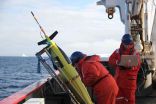INFORMATION: END
Sweet music or sour notes? The test will tell
UB researcher is developing an online singing test that evaluates accuracy of pitch
2014-11-10
(Press-News.org) BUFFALO, N.Y. - Most people rarely sing publicly outside of a duty-bound rendition of "Happy Birthday." And since that particular song is usually offered as a group performance, even the reluctant join in the spirit of the occasion, hoping their individual shortcomings will be cloaked by the chorus.
"I can't sing," says the hesitant performer. But a University at Buffalo psychologist believes that most people are not as bad at singing as they might think and he is collaborating on the development of an online test that will evaluate participants' ability to match specific tones and melodies.
Peter Q. Pfordresher is among seven researchers in psychology, neuroscience and music education from across the country working on the "Seattle Singing Accuracy Protocol (SSAP), a name derived from a 2013 workshop where the collaborators agreed on a set of core tasks that could be used to measure singing accuracy.
A description of that protocol will appear early next year in a special issue of the journal Music Perception that Pfordresher is co-editing with Steven Demorest, a professor of music education at Northwestern University.
The National Association for Music Education (NAFME) is funding the project.
Pfordresher says there are many ways to evaluate singing, but his research - and this project - is about accuracy not aesthetics.
"I study whether people are hitting an intended pitch or not," he says. "It's accurate versus inaccurate."
Pfordresher has always been interested in listening to people sing and identifying where they make mistakes. Formal study, however, began when he was still a student in graduate school working on a project that measured singing accuracy.
"That work got me thinking about what has to go right when we're singing tunes," says Pfordresher. "Is there a hierarchical structure in music that makes certain aspects easier to get right and certain aspects harder to get right?"
Research shows that most people have the gist, but miss the details. For instance, they usually don't mistake the direction of pitch changes when reproducing a melody. The notes they produce may be wildly inaccurate, but the changes in pitch direction, whether up or down are frequently spot on. They're also good at correctly reproducing large and small pitch intervals. Think of the two syllables in "somewhere" from the beginning of the Academy Award-winning ballad "Somewhere over the Rainbow" as a large interval and the two syllables in "over" as a small interval.
Yet a lot can still go wrong.
Singing involves low-level perception issues, such as pitch, duration, timbre and intensity. There is also a motor plan of action involving respiration, phonation and articulation. Pfordresher concentrates his research on the area between perception and action: what's called sensorimotor translation, or the ability to translate sound into action.
And it is, in fact, a form of translation.
"What goes on in our peripheral nervous system during listening is incredibly different than what has to go on when making sounds," says Pfordresher. "Production involves an entire network of muscles that all interact. So moving from listening to singing is like taking one language and translating it into another."
The SSAP will measure how well people handle the translation.
The program first guides participants through warmup exercises that determine their vocal range and arrives at a comfortable key in which to take the test. Then they hear a target melody and sing that melody back. Afterward, the performance is scored and wave forms display where their singing fell in relation to the target melody.
Pfordresher envisions three primary applications for the program.
"Early music education programs usually involve large groups. Generally, there isn't time to work extensively with individual students. This measure can provide educators with a tool to manage their time by pinpointing which students might need extra attention."
He says there is also a scientific application that will allow for broad-based measures of musical ability.
"The third reason is that people are interested," he says. "They want to know more about their musical abilities. I can see people taking this test and scoring better than expected. This can break down inhibition. Singing is fun, but many don't engage in it and research shows there are many benefits to doing so, from being helpful in social situations to stress reduction. More people singing is a good thing."
Intervention, though not part of the project, is the next big step.
There is suggestive evidence that visual feedback would be helpful. Poor-pitch singing might be, in part, an inability to imagine the right pitch. That failure of imagination is due to the inaccessibility. Singing requires an ensemble of muscles, but it is nearly impossible to observe those muscle movements. We can watch a tennis serve and subsequently model the movements, but such visualization in singing is not so easy.
"Evidence from research I conducted with Andrea Halpern concerning auditory imagery and singing shows that when we imagine a melody there is activity in various motor areas of the brain that are designed for motor planning," says Pfordresher. "People who are poor singers report significantly less imagery."
Pfordresher says we can also enhance the associations between pitch and voice. Poor singers tend to use a restrictive pitch range when imitating melodies - something they don't do when speaking - so poor singers may not have explored the full range of their singing voice.
"These are among the possible avenues of treatment," he says. "Whether they work is something to be determined."
ELSE PRESS RELEASES FROM THIS DATE:
SwRI-led team telescope effort reveals asteroid's size for the first time
2014-11-10
Boulder, Colo. -- Nov. 10, 2014 -- When the double asteroid Patroclus-Menoetius passed directly in front of a star on the night of Oct. 20, a team of volunteer astronomers across the U.S. was waiting.
Observing the event, known as an occultation, from multiple sites where each observer recorded the precise time the star was obscured, yielded the first accurate determination of the two objects' size and shape. The analysis was led by Dr. Marc W. Buie, staff scientist in Southwest Research Institute's (SwRI) Space Studies Department in Boulder, Colo.
The team effort was ...
Baby photos of a scaled-up solar system
2014-11-10
Scientists at the University of Arizona have discovered what might be the closest thing to "baby photos" of our solar system. A young star called HD 95086 is found to have two dust belts, analogous to the asteroid and Kuiper belts in the Solar System, surrounded by a large dust halo that only young planetary systems have.
Similar dust structures are also found around another, slightly older star called HR 8799, where four massive planets occupy the large gap between the two belts. HR 8799, the first star found to host four directly imaged planets, is often referred ...
Wireless devices used by casual pilots vulnerable to hacking, computer scientists find
2014-11-10
A new class of apps and wireless devices used by private pilots during flights for everything from GPS information to data about nearby aircraft is vulnerable to a wide range of security attacks, which in some scenarios could lead to catastrophic outcomes, according to computer scientists at the University of California, San Diego and Johns Hopkins University. They presented their findings Nov. 5 at the 21st ACM Conference on Computer and Communications Security in Scottsdale, Ariz.
`
Researchers examined three combinations of devices and apps most commonly used by private ...
Changes in a single gene's action can control addiction and depression-related behaviors
2014-11-10
Regulation of a single, specific gene in a brain region related to drug addiction and depression is sufficient to reduce drug and stress responses, according to a study conducted at the Icahn School of Medicine at Mount Sinai and published October 27 online in the journal Nature Neuroscience.
The Mount Sinai study focuses on epigenetics, the study of changes in the action of human genes caused, not by changes in DNA code we inherit from our parents, but instead by molecules that regulate when, where and to what degree our genetic material is activated.
Previous research ...
NASA sees System 05B fizzle in Bay of Bengal
2014-11-10
System 05B degenerated into a remnant low pressure area on Nov. 8 and lingered near the east-central coast of India for two days before dissipating on Nov. 10.
The tropical cyclone's western edge spread over land on Sunday, Nov. 9 while the center of the low-level circulation remained over open waters of the Bay of Bengal. On that day, 05B's remnants were centered near 14.0 north latitude and 83.8 east longitude, about 215 miles east-northeast of Chennai, India.
Infrared imagery from satellites on Nov. 9 indicated that the low-level circulation center of the storm was ...
Is your relationship moving toward marriage? If it isn't, you probably can't admit it
2014-11-10
URBANA, Ill. - Dating couples who have moved toward marriage over the course of their relationship remember accurately what was going on at each stage of their deepening commitment. But couples whose commitment to each other has stagnated or regressed are far less accurate in their memories of their relationships, says a new University of Illinois study.
"People like to feel that they're making progress as a couple. If they're not--if, in fact, the relationship is in trouble--they may have distorted recollections that help them feel like they're moving forward because ...
'Antibiogram' use in nursing facilities could help improve antibiotic use, effectiveness
2014-11-10
PORTLAND, Ore. - Use of "antibiograms" in skilled nursing facilities could improve antibiotic effectiveness and help address problems with antibiotic resistance that are becoming a national crisis, researchers conclude in a new study.
Antibiograms are tools that aid health care practitioners in prescribing antibiotics in local populations, such as a hospital, nursing home or the community. They are based on information from microbiology laboratory tests and provide information on how likely a certain antibiotic is to effectively treat a particular infection.
The recent ...
EARTH magazine: Solar storms cause spike in insurance claims
2014-11-10
Alexandria, Va. -- On March 13, 1989, a geomagnetic storm spawned by a solar outburst struck Earth, triggering instabilities in the electric-power grid that serves much of eastern Canada and the U.S. The storm led to blackouts for more than 6 million customers and caused tens of millions of dollars in damages and economic losses. More than 25 years later, the possibility of another such catastrophe still looms, and the day-to-day effects of space weather on electrical systems remain difficult to quantify. Now, a new study correlating electrical insurance claims with geomagnetic ...
Robotic ocean gliders aid study of melting polar ice
2014-11-10
The rapidly melting ice sheets on the coast of West Antarctica are a potential major contributor to rising ocean levels worldwide. Although warm water near the coast is thought to be the main factor causing the ice to melt, the process by which this water ends up near the cold continent is not well understood.
Using robotic ocean gliders, Caltech researchers have now found that swirling ocean eddies, similar to atmospheric storms, play an important role in transporting these warm waters to the Antarctic coast--a discovery that will help the scientific community determine ...
Interstitial lung disease is a significant risk factor for lung inflammation
2014-11-10
Interstitial lung disease is a significant risk factor for lung inflammation following stereotactic body radiation therapy for lung cancer.
DENVER - Pretreatment interstitial lung disease (ILD) is a significant risk factor for developing symptomatic and severe radiation pneumonitis in stage I non-small cell lung cancer (NSCLC) patients treated with stereotactic body radiation therapy (SBRT) alone.
ILD is a group of diseases that cause scarring and stiffing of the tissue and space around the air sacs in the lungs, which results in diminished gas exchange. The incidence ...
LAST 30 PRESS RELEASES:
Studies investigate how AI can aid clinicians in analyzing medical images
Researchers pitch strategies to identify potential fraudulent participants in online qualitative research
Sweeping study shows similar genetic factors underlie multiple psychiatric disorders
How extreme weather events affect agricultural trade between US states
Smallholder farms maintain strong pollinator diversity – even when far from forests
Price of a bot army revealed across hundreds of online platforms worldwide – from TikTok to Amazon
Warblers borrow color-related genes from evolutionary neighbors, study finds
Heat signaling from plants is an ancient pollinator signal
New index reveals the economics underlying the online manipulation economy
High-resolution satellite observations reveal facility-level methane emissions worldwide
Researchers discover how Ebola and Marburg disrupt the gastrointestinal tract
Feeling the heat
Eastward earthquake rupture progression along the Main Marmara Fault towards Istanbul
Scientists uncover how Earth’s mantle locked away vast water in early magma ocean
Scientists uncover key driver of treatment-resistant cancer
Rare image of Tatooine-like planet is closest to its twin stars yet
Music: Popular song lyrics have become more negative since 1973
Marine ecology: Killer whales tail dolphins to hunt salmon
ADHD prescriptions on the rise, study finds
How to build a genome
Sharp rise in ADHD stimulant prescriptions in Ontario, research finds
Trends and prevalence of the metabolic syndrome among US adults
Population-level trends in ADHD medication prescribing
Missing piece of myelin disturbs the brain’s rhythm
Insilico Medicine and Taigen achieves license agreement to develop and commercialize AI-driven PHD inhibitor for anemia of Chronic Kidney Disease (CKD)
Exploring dominant endophytic Pleosporales in grasses: New taxonomic insights in the suborder Massarineae
Comparative transcriptomic analysis of human maxillary and mandibular tooth germs reveals discrepancies in gene expression patterns
Scientists detect atmosphere on molten rocky exoplanet - study
Chip-scale magnetometer uses light for high-precision magnetic sensing
Illinois Tech biomedical engineering professor Philip R. Troyk elected as Fellow of the National Academy of Inventors
[Press-News.org] Sweet music or sour notes? The test will tellUB researcher is developing an online singing test that evaluates accuracy of pitch




